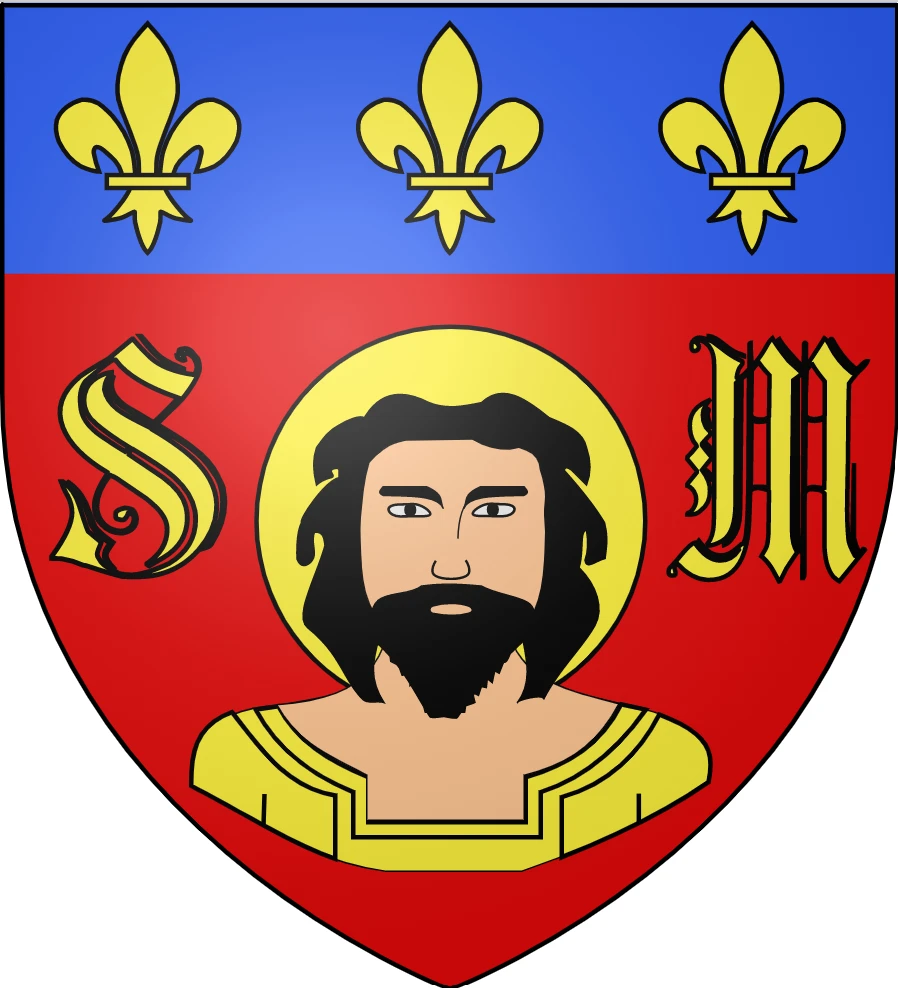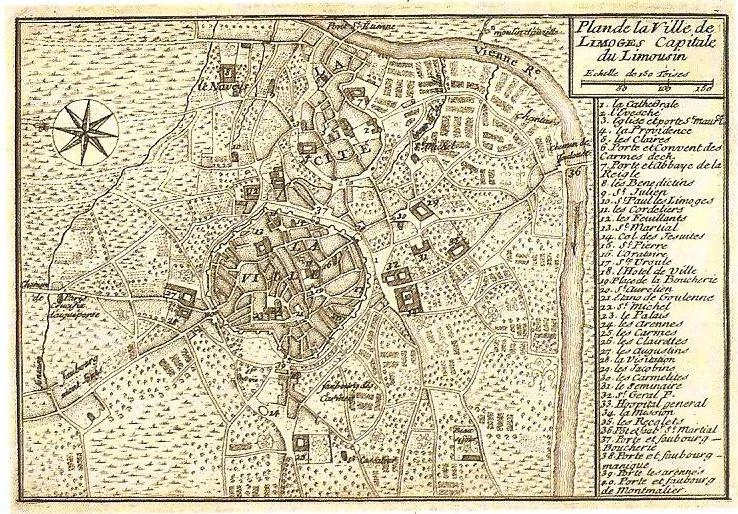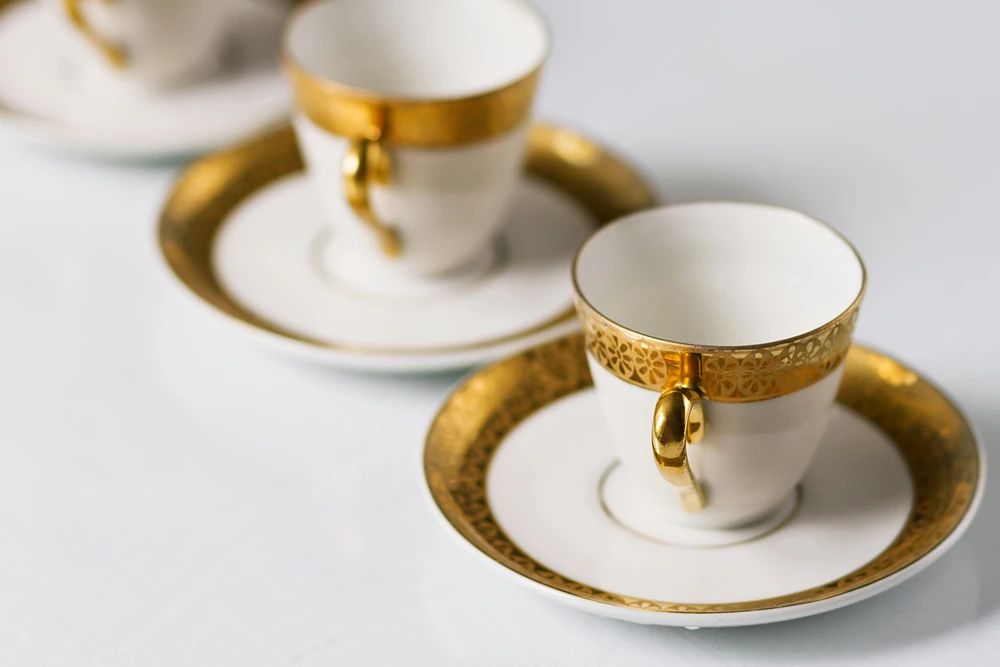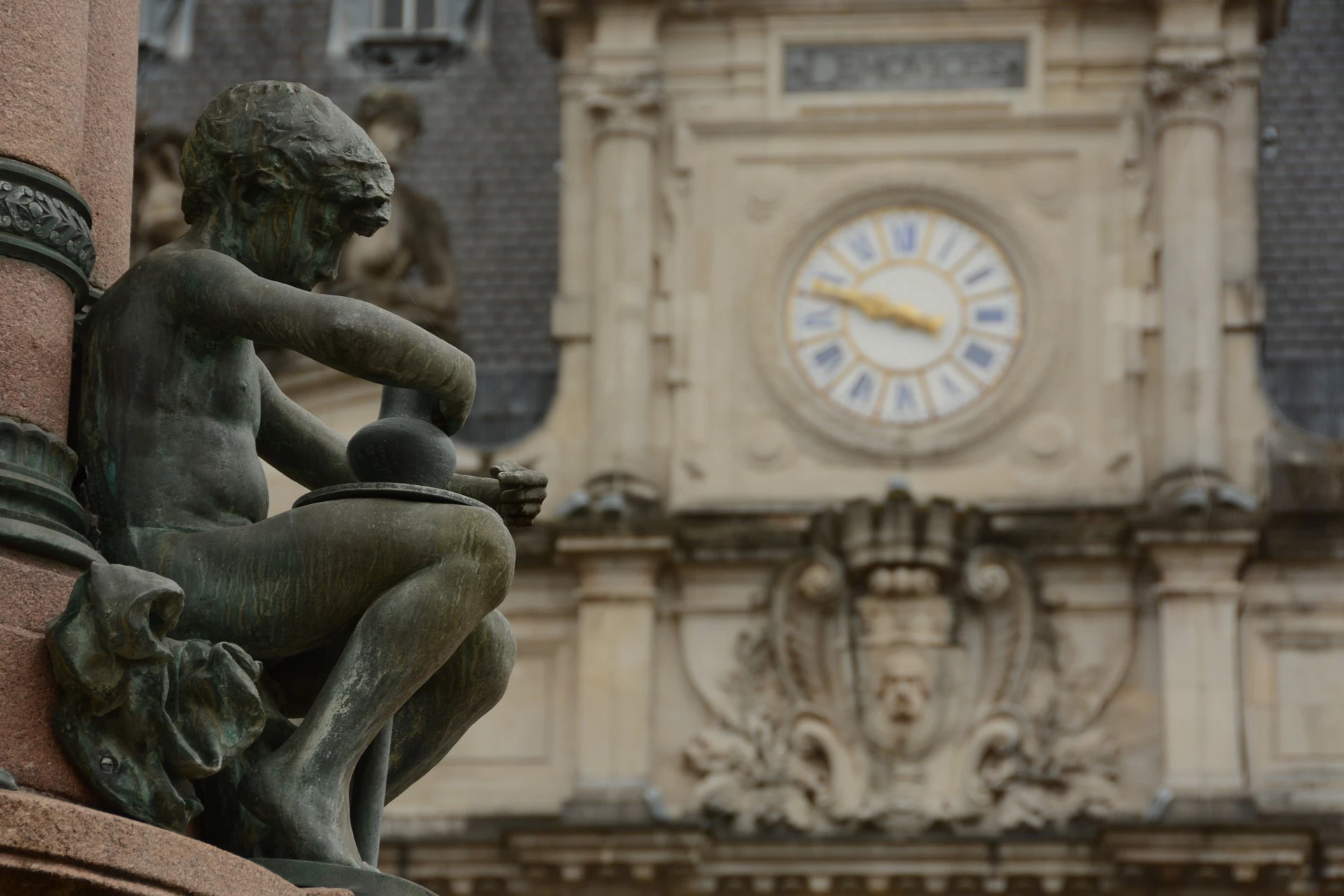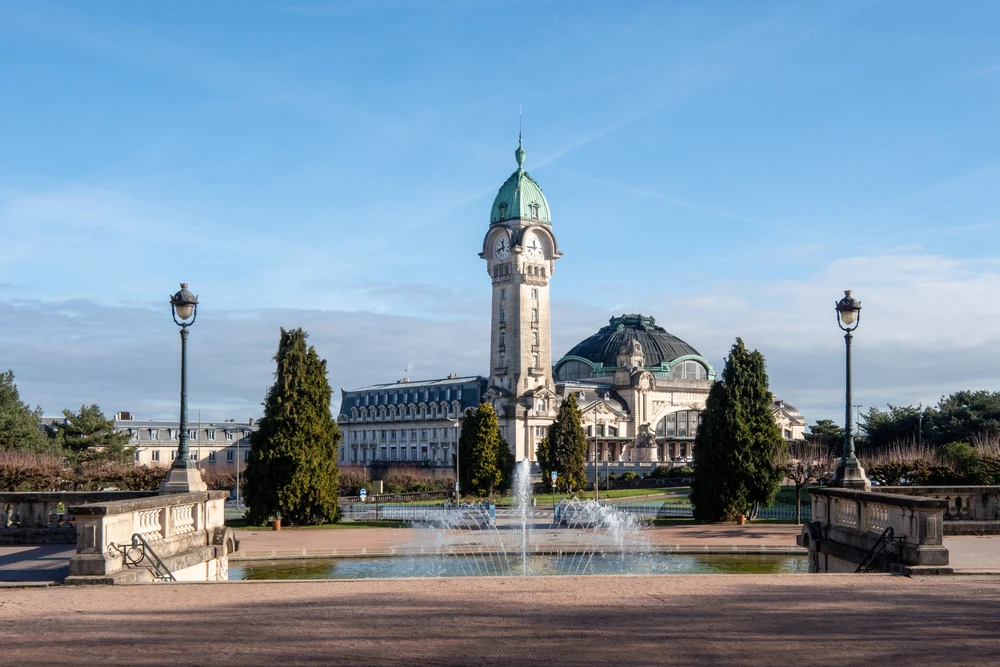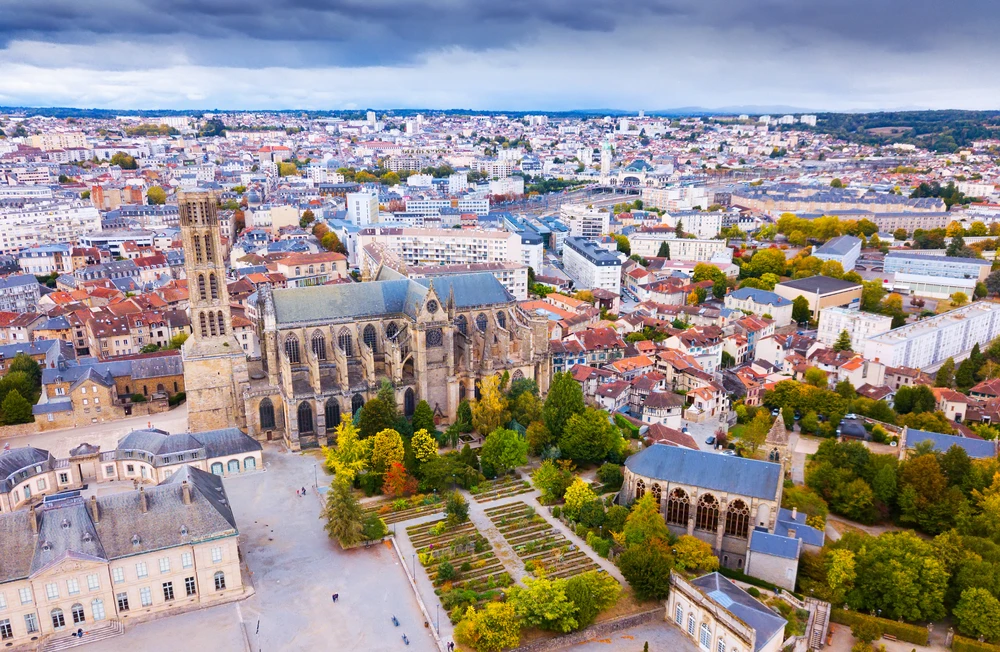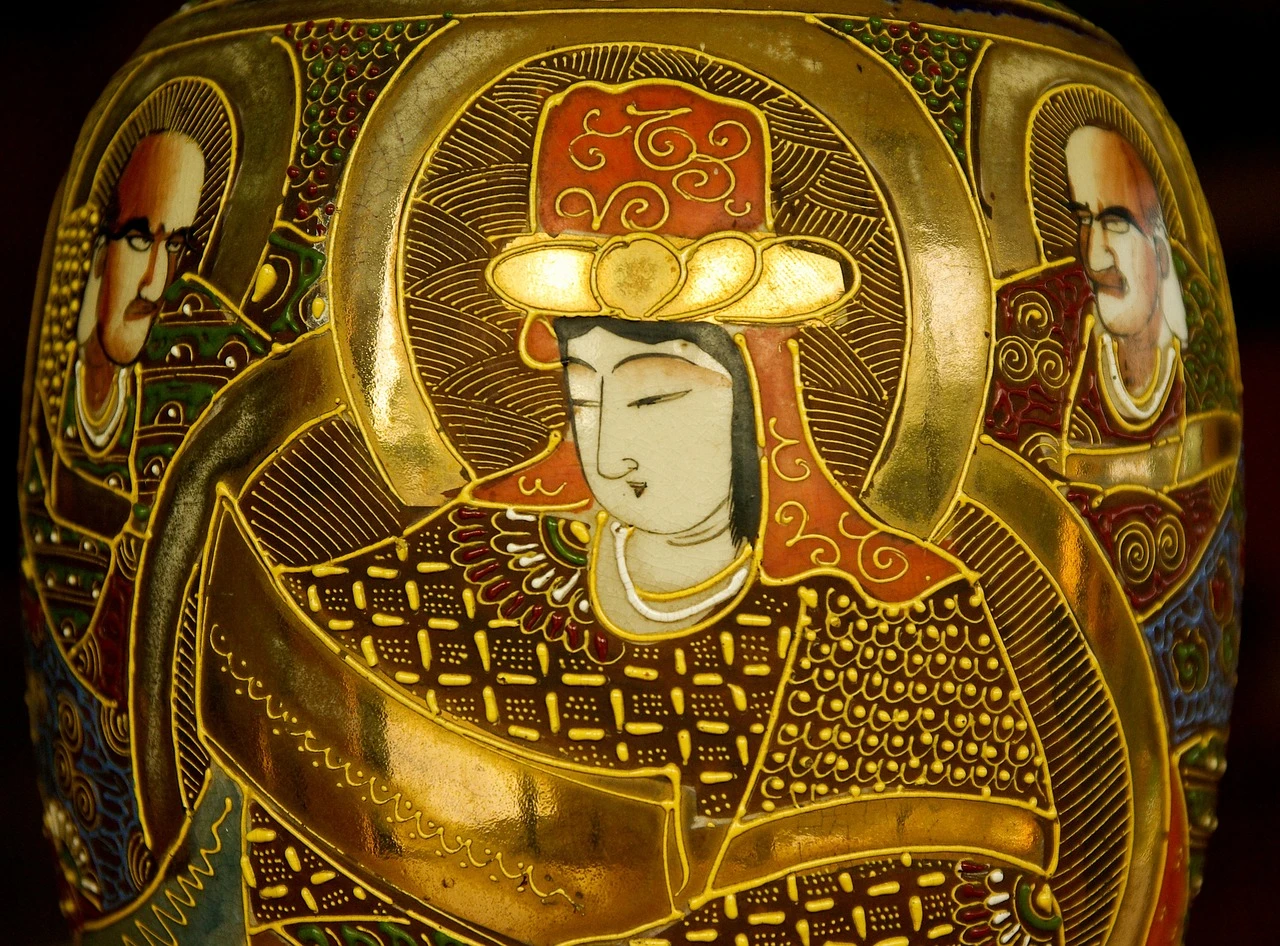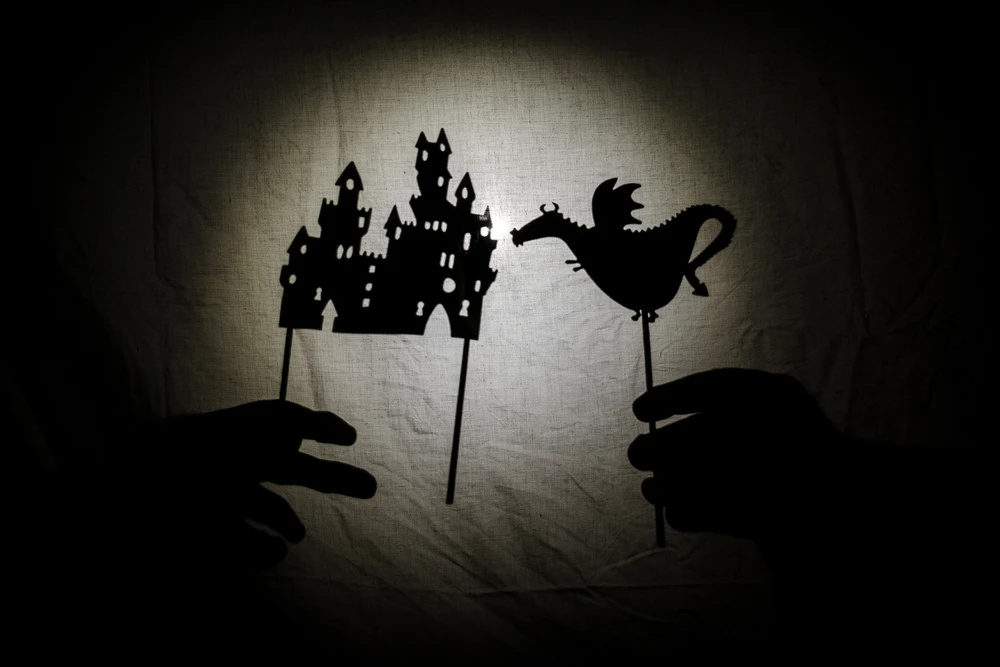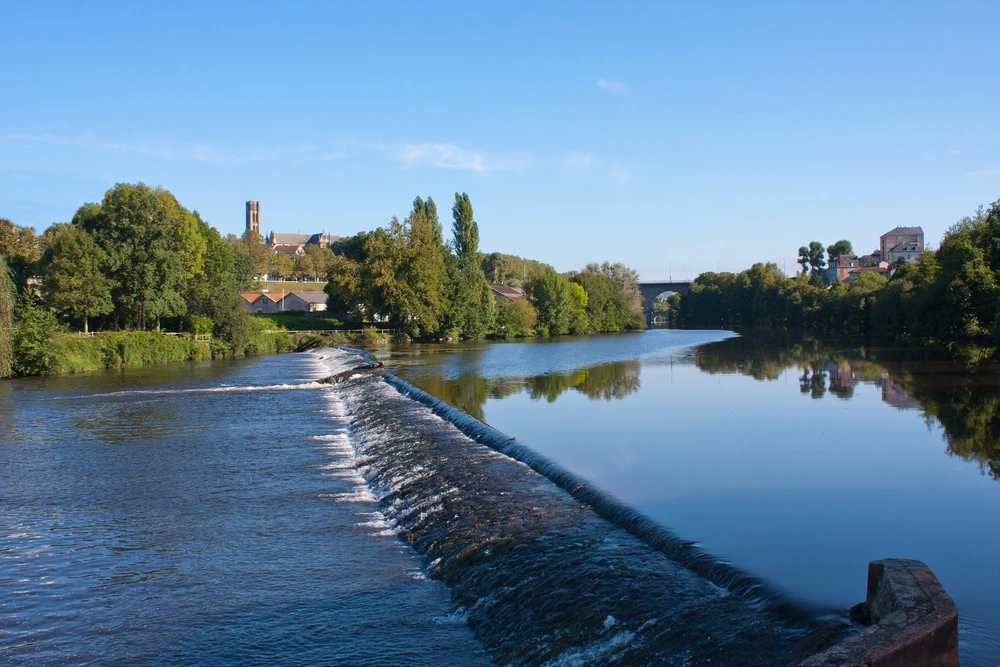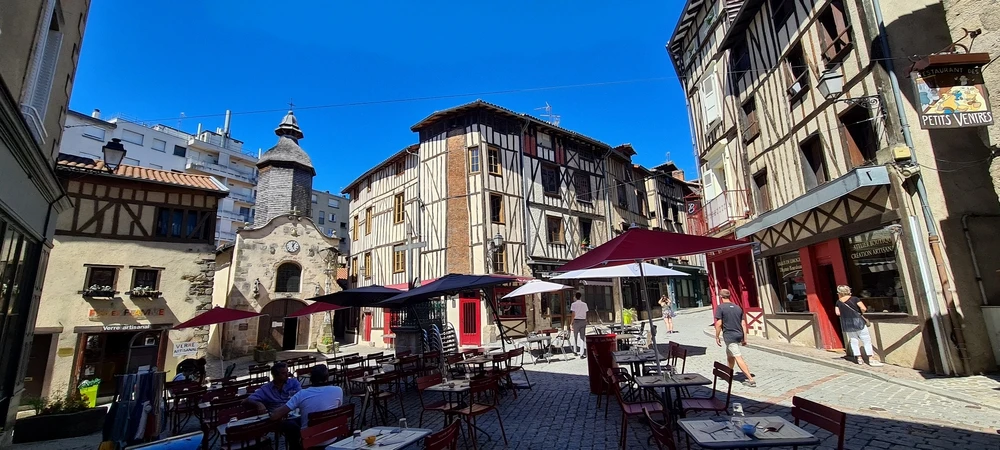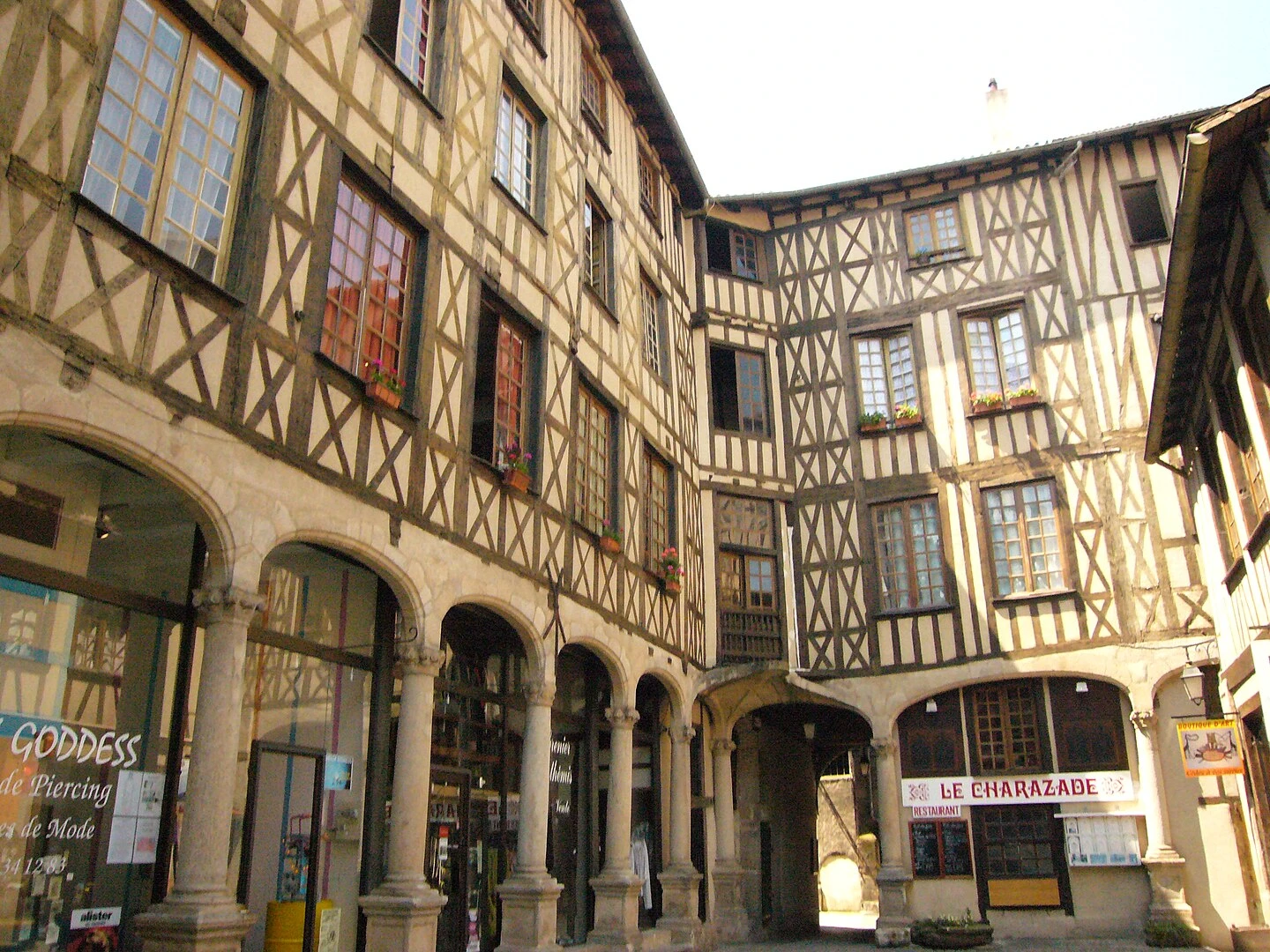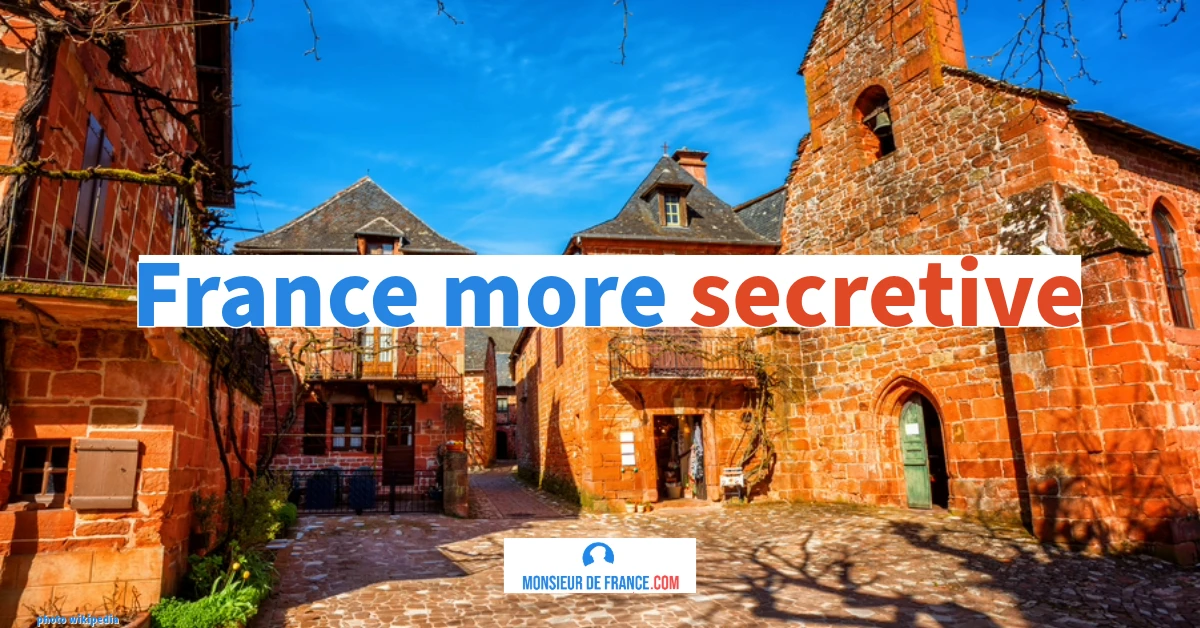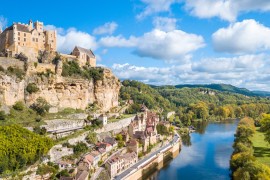Limoges: what history?
The city of Lemovices becomes Limoges in the Middle Ages
The astonishing Limoges coat of arms: Gules, on a chief of Saint Martial de carnation, ornamented antique Or, ombré Sable, between two gothic letters Or S and M; on a chief Azure, three fleurs-de-lis Or (wikipedia).
Thank you Romans! In the 1st century, they founded Augustoritum, a large Gallo-Roman city on a ford of the Vienne River. With the fall of the Empire, Augustoritum gradually fell into oblivion in favor of "Limoges", a name derived from the Gallic tribe of Lémovices. Capital of Limousin, the city gained in importance in the Medieval Age, when the Dukes of Aquitaine were invested and crowned there. La cité de l'évêque (around the cathedral) and le quartier du Château (around the viscounty) coexisted for a long time, before being unified at the Revolution.
The city of the Dukes of Aquitaine, a city of knowledge
The high Middle Ages saw the rise of the abbey of Saint-Martial, a spiritual and intellectual hotbed whose fame extended beyond Limousin. Here art, science and music are cultivated, to the point of giving its name to the "Saint-Martial school" for Gregorian chant. A city of artists, Limoges launches troubadours; troubled times (Hundred Years' War, Wars of Religion) don't dent its dynamism for long.
Limoges in 1765 / By Cornuau
A city that has always been "gifted with its hands
Limoges was an early manufacturing town : tissus (limogiatures au Moyen Âge), enamel réputée dès le XIIᵉ siècle, puis porcelaine à partir de la fin du XVIIIᵉ siècle. The discovery of a kaolin deposit à Saint-Yrieix-la-Perche (1768) propulse l’industrie locale : quality tableware conquiert l’Europe et fait la fortune des manufactures.
Limoges porcelain Photo by Ondacaracola/Shutterstock
City of workers and know-how
In the XVIIIᵉ-XIXᵉ centuries, porcelain, textiles, leather, hats structured the economy; Limoges became a major working-class city, "the red city", even "the Rome of socialism" according to the local militant tradition. Today, the city assumes a dual face: academic, heritage and creative.
What to see in Limoges The essential Top 5
Limoges town hall clock / Image by Annabel_P de Pixabay
1. Limoges-Bénédictins station: the Art Deco icon
Limoges railway station Photo by BearFotos/Shutterstock
Inaugurated in 1929, the gare des Bénédictins is one of the most beautiful in France. Its dome, campanile-clock and stained-glass windows make up an architectural manifesto blending neoclassicism, Art Nouveau and Art Deco, with a hint of regionalism. A symbol of Limoges, it impresses as much with its silhouette as with its siting above the tracks. To see: the great hall, the glass roof, the floral decorations; to photograph: the station from the esplanade and from the banks of the Vienne, where the dome stands out against the hill. Tip: enter, look up, then gain the place Maison-Dieu for a beautiful perspective. For a full tour, ask the Ville d'art et d'histoire: guided tours are available depending on the season.
2. Saint-Étienne Cathedral and the Cité district
Begun in 1273 and completed in 1888, St. Stephen's Cathedral offers a striking reading of six centuries of construction: radiating Gothic in the chevet and ambulatory, late nave, Romanesque bell tower connected to the nave in the XIXᵉ century. The carved rood screen, the chapels, the windows and the portal command attention; the terraced gardens of the Bishopric form a perfect backdrop for admiring the silhouette of the edifice and descending to the Vienne. Visit tip: in the morning for the light on the chevet and a stroll through the botanical garden (collections, "French-style" terraces), then in the afternoon for the interiors and ambience of the Cité.
Limoges Cathedral Photo by BearFotos/Shutterstock
3. The Boucherie and Halles districts
Medieval immersion guaranteed in the quartier de la Boucherie, picturesque with its half-timbered houses, narrow alleyways and chapelle Saint-Aurélien. Rue de la Boucherie (La Bocharia in Occitan), the memory of a very active guild from the Middle Ages to modern times is perpetuated; the traditional Maison de la Boucherie recounts the gestures, tools and sociability of a long-popular neighborhood. Don't miss the neighboring Halles for the marché: here you'll find the gourmet spirit of a capital of Limousin renowned for its limousine beef, fine and "au beau grain". In the evening, head up to the place de la Motte for the atmosphere of the terraces and the highlighted timber-framed facades.
Houses of Limoges Photo by ilolab/Shutterstock
4. Parks and gardens: the bishopric and the green city
At Limoges you should also browse the gardens / Image by Nikolett Emmert de Pixabay
52 m² of green space per inhabitant: Limoges also lives outdoors. Les jardins de l'Évêché, the "pearl" of the city center, tier their flowered terraces at the foot of the cathedral and unfurl a botanical garden (nearly 2 ha) rich in collections (plant families, uses, Limousin biotopes). Parc Victor-Thuillat, parc de l'Aurence and promenades along the Vienne complete the picture. Photo idea: from the high terraces, frame the cathedral with the French-style flowerbeds; in the late afternoon, aim for the bridges over the Vienne for reflections.
5. Limoges porcelain: stores, museum and living expertise
Porcelaine de Limoges Photo par Andrei Antipov/Shutterstock
Limoges continues to make the porcelain to which it gave its name shine. Between boulevard Louis-Blanc (the "Champs-Élysées of porcelain"), factory shops, workshops and Fondation Bernardaud (exhibitions), the savoir-faire is explored in stores and museums. Must-see: the musée national Adrien-Dubouché, the world's richest public collection of Limoges porcelain and a complete panorama of ceramics, from Antiquity to the present day, with some 18,000 works (around 5,000 on display). Tip: allow 1 h 30 to 2 h to appreciate the materials, pastes, decorations, and understand the stages of manufacture.
Why porcelain in Limoges? The story of a great passion
Chinese porcelain / Image by jacqueline macou de Pixabay
Chinese porcelain, the ruinous passion of Enlightenment Europe
For centuries, Europe went broke for Chinese porcelain: from the "Chinese" salons to Versailles or Haroué, these marvels with their fantasized decorations were exhibited. Armateurs and marchants prosper; courts collect; scholars seek the secret of manufacture.
A priest from Limoges "hacks" secrecy in China
François-Xavier d'Entrecolles, Jesuit born in Limoges (1664), observe au début du XVIIIᵉ siècle les Chinese techniques et unveils enfin the process dans une lettre publiée en 1712. Saxony takes it over, France is lagging behind… the kaolin is missing.
Chance of history: kaolin found near Limoges
1768: a kaolin deposit is discovered at Saint-Yrieix-la-Perche. Everything accelerates: manufactures are set up, Limoges becomes France's porcelain capital, tableware is refined and exported. Two centuries later, the musée Adrien-Dubouché enshrines this history and the workshops perpetuate the know-how.
Letter from père d'Entrecolles in 1712 telling how porcelain is made in China. Published by du Halde in 1735.
The amazing story of the word "silhouette" born in Limoges
The name Silhouette is first a Limoges patronymic: Étienne de Silhouette (1709-1767), controller general of Finances for Louis XV, ironically gave his name to the portraits "à la silhouette" - cut-out black profile - that became fashionable. Born in Limoges, the man of the Lumières symbolizes an era when people liked to classify, invent, economize: a historical wink that the city gladly claims.
Shadow puppets Photo by Jordi Mora/Shutterstock
Suggested route: Limoges on foot, from east to west
Les quais de la Vienne à Limoges / Photo chosen by Monsieur de France: depositphotos
Stage 1: City, cathedral and gardens
Start place de la Cathédrale for the chevet and Gothic volumes; cross the jardin de l'Évêché by the terrasses (useful plants, Limousin ecological collection), descend to the Vienne to feel the original settlement of Augustoritum.
Stage 2: Vienne river bridges and city views
Join the pont Saint-Étienne, one of the best-preserved medieval bridges: broken arches, avant-becs and contreforts. Superb view of the cathedral. Follow the riverbank and take the measure of the city by the water.
Stage 3: Butchery district, covered market and traditional house
The Boucherie district in Limoges / Photo chosen by Monsieur de France: depositphotos
Head up the rue de la Boucherie: wood-framed houses, ruelles, chapelle Saint-Aurélien. La Maison traditionnelle tells of the guild; les halles regale with local produce. This is the popular and tourist heart of Limoges, where you'll often come across galleries and artisans.
Stage 4: Downtown shopping and museums
Via the place de la Motte, reach the musée des Beaux-Arts (former episcopal palace: Limoges enamels and collections from the Middle Ages to contemporary times), then the musée national Adrien-Dubouché for the epic of ceramics.
The temple courtyard in Limoges / Photo chosen by monsieurdefrance.com : By Babsy - Own work, CC BY 3.0, https://commons.wikimedia.org/w/index.php?curid=4188261
Stage 5: Esplanade des Bénédictins and outlook
Finish at the gare des Bénédictins: dome, campanile, stained glass and monumental volumes. Photograph the dome at sunset, then return to the old town for the evening.
Practical information for visiting Limoges
Limoges its town hall and a fountain by Jade de Pixabay
Access and orientation
Train : Limoges-Bénédictins station (lignes vers Paris-Austerlitz, Brive, Périgueux, etc.).
Voiture : A20 (Paris–Toulouse) dessert la ville ; parkings autour du centre.
Avion : Limoges-Bellegarde Airport (vols selon saison).
Tourist office : Destination Limoges (informations, visites guidées, City Pass).
How long will it take?
One day for the essentials (cathedral, Boucherie, station, gardens); one weekend to add Adrien-Dubouché museum, Beaux-Arts, promenades and china shops.
When to come?
Spring-fall for gardens and light on stone; winter for museums and interiors; summer for Vienna and evening photos.
Good to know
University town and creative, Limoges boasts regular programming (festivals, "Ville d'art et d'histoire" tours). Find out more at the office for guided tours of the train station or historic districts, and for the City Pass (admissions and discounts).
Astuce
Start with the cathedral and bishop's gardens in the morning, move on to the Adrien-Dubouché museum after lunch, continue on to the Boucherie and finish at the Benedictines for the golden light: you'll have embraced the soul of Limoges without running.
FAQ
What is Limoges' specialty?
The porcelain: a skill born of the discovery of kaolin in the XVIIIᵉ century, magnified by the manufactures and by the musée national Adrien-Dubouché.
What's not to miss in Limoges?
Saint-Etienne Cathedral, Bishop's gardens, Boucherie district, Benedictine station, Adrien-Dubouché museum, walks on the Vienne river.
Where to see Limoges porcelain?
In boutiques (boulevard Louis-Blanc and factory outlets) and at the musée national Adrien-Dubouché (collections, techniques, history of ceramics).
Do you visit Limoges on foot?
Yes. Compact heritage center, ruelles, berges de la Vienne: the city is savored on foot, complemented by bus and shuttles to get away.
Practical information – Limoges
Access / How to get there
Limoges is very well connected. From Paris, it takes around 3 hours 15 minutes by train (Intercités from Austerlitz station). By car, take the A20 (free between Vierzon and Brive), which takes around 4 hours 30 minutes from Paris and 2 hours 30 minutes from Toulouse. Limoges-Bellegarde Airport, located 15 minutes from the city center, offers direct flights to Lyon, Nice, Marseille, Paris, London, and Bristol. A shuttle bus connects the airport to the city center. Limoges-Bénédictins train station, considered one of the most beautiful in France, is a stone's throw from the city center and the main tourist attractions.
Prices and visiting tips
Most municipal museums are free on the first Sunday of the month. The Musée national Adrien Dubouché, dedicated to porcelain, costs around €7, and the Musée des Beaux-Arts around €5 (reduced rate €3). The Musée de la Résistance has similar prices. A combined ticket gives you access to several museums at a preferential rate. Guided tours from the Tourist Office (historical, themed, or night tours) are available from €10. To save time, consider booking your tickets online, especially during the summer or on weekends.
Useful contacts
Limoges Métropole Tourist Office
12 boulevard de Fleurus, 87000 Limoges
Phone: +33 (0)5 55 34 46 87
Email: info@destination-limoges.com
Official website: www.destination-limoges.com
Updated:
October 2025

